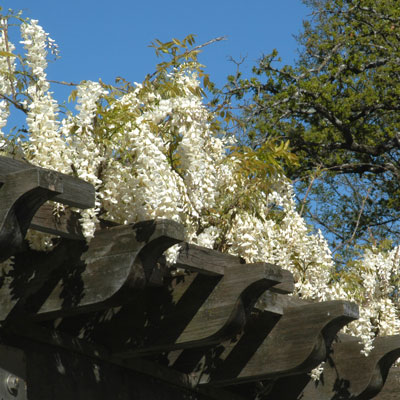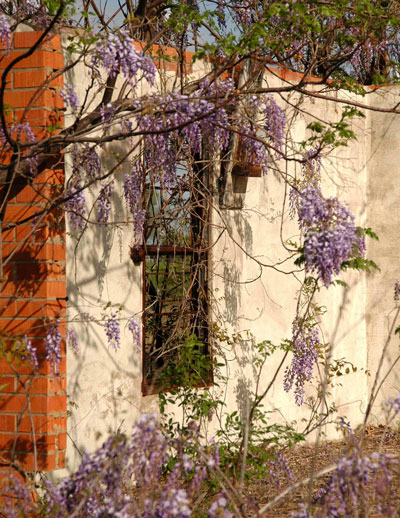Question of the Week: April 7, 2016
Thousands of people are asking the same question across Texas this week.
“Why didn’t my wisteria bloom this spring? In fact, it never flowers. What gives?”

This wisteria blooms heavily each spring from an alkaline and rocky outcropping in Collin County.
When I think of all the questions people ask about vines, this is the one that is on top. Unfortunately, there’s no one good answer. It may be one or more of the following:
• Wisterias need sun. Preferably full sun, dawn ‘til dusk. Once you give them more than a couple of hours of shade daily in summer, their flowering will decline.

This white selection is blooming atop a covered patio – full sun and then some.
• You must not prune wisterias in winter. They set their flower buds in the fall, and winter pruning will remove most or all of them. That also goes for climbing roses, Carolina jessamine, wisteria, azaleas, forsythia and other spring-blooming plants. All of these plants should be pruned immediately after they finish flowering. Or, if they fail to bloom, after when they should have flowered.
• If you give wisterias nitrogen from summer on, you’re likely to get strongly vegetative growth (at the expense of flower bud production). That most commonly happens when we grow wisterias in or near turfgrass, and when we apply the important fall feeding of a high-nitrogen or all-nitrogen fertilizer to our lawns in September or early October.
• Some contend that the non-blooming wisterias have been propagated from plants that have that genetic predisposition not to bloom. However, others of us ask why anyone would be saving that sort of a failed plant and trying to start new plants from it.
A possible solution? Try root-pruning your wisteria in early September. After a deep watering or heavy rain (if you’re lucky enough to get one), use a sharpshooter spade to cut a slit 10 or 12 inches deep and 15 inches out from the trunk. You won’t be removing any soil – just severing the roots. Your hope would be that the shock of that root-pruning would throw the plant into a “survival-of-the-species” reproductive (blooming) mode. It’s worth a try, and it often does work.

Wisterias often outlive the homes where they were planted. Photo is from Wills Point, taken several years ago.
